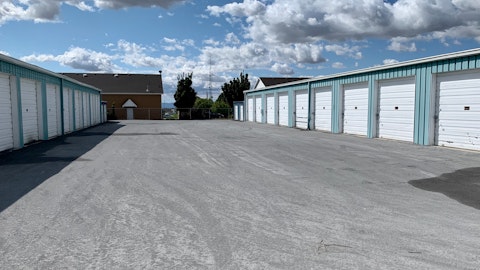And so — but that’s very positive for me because it’s still a move. We want to capture all the moves. We can’t self-move and so, yes, I think you’d have to say and we would say I think that our productivity per location is down a decimal point or something, not a tremendous amount, but a small change there has a big change in — ultimately into cash flow and profitability. So we’re always watching this and also the productivity of the equipment by equipment type and volume. And we’re doing some realigning there that we’re a little behind, I don’t know, maybe 4 months behind on sales, Jason, you say. Maybe we’re 4 months behind what we would like to have been on sales. But sales are now catching up after we didn’t sell trucks for about 2 years there because we couldn’t buy any.
So now we’re rotating some of those trucks out into the for-sale market, which will kind of help clear out our volume of repair because the oldest trucks obviously create the most repair.
Keegan Carl: Got it. And I think your commentary on one-way moves is interesting. I’m just curious, do you know what percentage of your moves or what percentage of your revenues you’d attribute specifically to the one-way moves?
Jason Berg: Yes. This is Jason. The one-way revenue is probably 46% to 47% of the total truck rent revenue.
Keegan Carl: Got it. That’s really helpful. I guess shifting gears here to Storage. On a relative basis in your portfolio, it’s performing well. I’m just curious, do you know what percentage of your customers are tied to movement more short term in nature? And I guess what sort of upside do you see in that business of existing home sales start to improve?
Joe Shoen: I don’t know that home sales will impact it at all. Roughly 40% of people live in rental arrangements and maybe it’s more than that if we knew the truth where people are multi-families under one roof. So I wouldn’t — we’ve never seen a high correlation between new home sales and the business. We’ve seen a very positive correlation between overall consumer optimism and moves, which kind of makes sense because if you kind of feel good about things, you’re more likely to take the risk of moving. So if that’s an answer to your question.
Keegan Carl: Okay. And then maybe on storage pricing power, I thought your commentary was interesting that you rent roll-up, which is much different than your public peers. I guess how are you thinking about rate increases in your existing customer base because you actually have a revenue tailwind if they move out?
Jason Berg: Sure. This is Jason. We have a very methodical approach to rate increases, which I think in the last year, the competition was much more aggressive than what you saw us be. So they’re kind of dealing with the effects of that, whereas I think we still have some upside now with them reacting to their situation could have an effect on us and could impact how successful our rate increases stick. Now we normally just go about working our plan regardless of what everyone else is doing. If we’re providing a good product and service to folks, we stick with it. So I think we still have opportunity that I look at kind of an estimate of our discounting, and that was not up appreciably, perhaps a couple of hundred thousand based upon my estimate.
So we haven’t gone that route. We don’t really do advertising outside of the U-Box product. So we haven’t increased anything there. So I would say I’m concerned based upon what I’m seeing, but our team is just forging ahead. And that’s worked for us in the past, and I have no reason to believe it will work for us today. I’ve looked at facilities we’ve opened in the last year, and they’re still filling up at the same rate or faster than what facilities have opened up in the last 3 to 4 years.
Keegan Carl: Got it. That’s super helpful. And then maybe just shifting gears here to the final topic, really focused on CapEx associated with your new fleet. I guess just any update on how they’re refreshing of the fleet is going? And then I know you mentioned sales are down on your used trucks from a pricing perspective. Just kind of curious maybe how down is it on a year-over-year basis?
Jason Berg: Sure. I’ll hit this first before Joe does because it’s important to look at our truck sales in 2 pieces, right? There’s the smaller trucks and cargo vans that sell in and out much more frequently. In that section, we’ve increased the pace of sales this year and the prices that we’re seeing at auction and wholesale have come down. So our average gain has decreased. On the trucks that Joe was referring to earlier about us kind of being behind in sales, that would be the larger trucks, the 10-foot trucks up to the 26-foot trucks. There, we’re about where we were at last year on truck sales, but we pulled a few more thousand from the fleet prepping them for sale. And that’s where we’re likely to get the benefit on the repair and maintenance side is by pulling those trucks out because those are the trucks that we’re holding 10 to 15 years in the fleet.
And throughout the strike, we have not had an issue as far as getting those new cabs and chassis, fortunately. So this has been a, I’ll call it, a pretty good year as far as bringing in new equipment, albeit at a higher price.
Keegan Carl: Got it. And I guess, is it fair to assume that as you guys work through replacing the fleet that your near-term CapEx will ramp, but there’s going to be a material decline in maintenance CapEx. Is that the right way to be thinking about it?
Jason Berg: Well, our — I’ve had this discussion with folks on the phone. The $1.6 billion gross that we’re going to spend this year probably on fleet, I don’t know which part was growth, which part was maintenance. At the point that we’re at in the cycle now, unfortunately, all of it is kind of maintenance CapEx and I think we have another year or so of that. And then we’ll settle back down and figure out what the maintenance CapEx number is going to be. It used to be kind of a net $600 million give or take, it’s climbed from the mid-500s to with today’s pricing and size of the fleet to maybe the mid-600s. I think we need the pricing environment to settle down and then where we’re going to settle on the size of the fleet to figure out a good run rate on where maintenance CapEx will end up.



